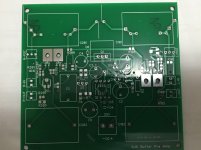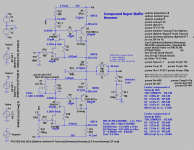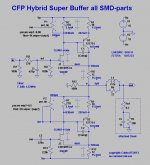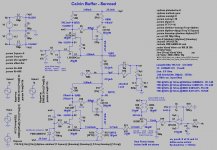....................
Remember, coupling caps blow and should always be avoided if possible...................
Could you explain?
How about an explanation instead of a rule breaking put down?Andrew, as long as you've been on this site and as many posts you've replied to, you would be one of the last members I expect to not understand such a simple statement.
Ammel, as you said number of components is the main reason I picked Feucht buffer over Calvin's. Another reason it is an AC coupled design. Means two power supplies.
Calvin's is a very low distortion design and can supply enough power to drive any cable. I am planning to make it too.
But B1 being a simple design using only local feed back through degeneration resistors( lowest feed back possible) I want to try it first. I believe its second harmonic predominant distortions profile may be the reason you did not like it.
While I acknowledge Calvin's point of thermal runaway and latch up with near maximum Vds you can see the designs by EUVL linked on the initial post for this simple buffer.
I will keep you guys posted over the many next weeks how it went.
Calvin's is a very low distortion design and can supply enough power to drive any cable. I am planning to make it too.
But B1 being a simple design using only local feed back through degeneration resistors( lowest feed back possible) I want to try it first. I believe its second harmonic predominant distortions profile may be the reason you did not like it.
While I acknowledge Calvin's point of thermal runaway and latch up with near maximum Vds you can see the designs by EUVL linked on the initial post for this simple buffer.
I will keep you guys posted over the many next weeks how it went.
How about an explanation instead of a rule breaking put down?
What the hell is a "rule breaking put down"?
Is this some type of "Scottish" term??
If you(and others here) prefer coupling caps in any given low-level preamp or buffer circuit, by all means continue using them and PLEASE report back to me if Mundorf "Supreme" caps should happen to sound better than Soniccap Gen 1 or Gen 2 caps, or perhaps better than any of the Vishay MKP caps...LOL.
Then there are the folks out there that find the Elna Silmic II polarized electrolytic caps sound good when used as coupling caps.
The debate over the "best sounding" MKP or electrolytic caps has been going on for some time and will probably continue well into the future.
Andrew, in case you haven't figured it out by now, I personally think the BEST sounding coupling cap is NO coupling cap at all!
Either figure out a way to match the input devices closer or implement a servo.
PLEASE...Don't act like you don't know what I'm referring to when it comes to coupling caps and they're role in a B1 circuit or any other circuit.
If using closely matched K170BLs, the need for those big ole' nasty 10uF output caps isn't necessary. I know since I've built several iterations of the B1 circuit.
Unfortunately, I didn't like the "sterile" SQ with or without coupling caps.
Yes, coupling caps play a major role in power amps to block any excessive DC that some moron might feed into it resulting in your speakers' woofers to take a big ole' dump and possibly their voice coils letting out the so called "magic smoke".
Now...let's bust out the moonshine and soldering iron and build something!
Got the PCB back.
That was quick! Let us know how it turns out.
Hi,
Kinku, see the attachments.
The first is the Calvin Buffer by Klaus Hesener as add-on for the Paradise Phono. Its all-throughhole parts
The second is a non-cascoded all-SMD version, which behaves almost equal in simulation to the Calvin Buffer, apart from minor raised THD into very low load impedances.
Third is an all-SMD Calvin Buffer with dc-servo, if one doesn´t want to rely on hand-trimmining pots and/or a dc-blocking output cap.
The main differences between the second and the third are:
- higher heat losses in 2nd´s JFETs due to higher Vds
- Cascoded JFETs in the third ´eat up´ at least 5V each of the supply voltage.
To achive the same maximum undistorted output voltage requires 10V or more higher supply rails (20V as in Your design maybe a bit too low already).
In contrast the second circuit may run on as low as +-5V rails for 2Vrms output ... which reduces the heat issue at the same.
All of these ´boosted´Buffers have the advantage that they allow for considerably higher load currents and/or can drive lower load impedances.
Sonically the simple JFET or cascoded JFET buffers tend to sound not as authorative as the boosted ones, especially the less supply decoupling capacitance is used.
So yes, the parts number count does increase to a simple JFET-Buffer or a B1, but costwise it doesn´t make a real difference ..... and matching and sourcing same gender parts is easier than for complementary parts.
Of course can all three examples be designd to be supplied from single or dual supplies.
You may also have a look at this Thread ... from #52 on.
jauu
Calvin
Kinku, see the attachments.
The first is the Calvin Buffer by Klaus Hesener as add-on for the Paradise Phono. Its all-throughhole parts
The second is a non-cascoded all-SMD version, which behaves almost equal in simulation to the Calvin Buffer, apart from minor raised THD into very low load impedances.
Third is an all-SMD Calvin Buffer with dc-servo, if one doesn´t want to rely on hand-trimmining pots and/or a dc-blocking output cap.
The main differences between the second and the third are:
- higher heat losses in 2nd´s JFETs due to higher Vds
- Cascoded JFETs in the third ´eat up´ at least 5V each of the supply voltage.
To achive the same maximum undistorted output voltage requires 10V or more higher supply rails (20V as in Your design maybe a bit too low already).
In contrast the second circuit may run on as low as +-5V rails for 2Vrms output ... which reduces the heat issue at the same.
All of these ´boosted´Buffers have the advantage that they allow for considerably higher load currents and/or can drive lower load impedances.
Sonically the simple JFET or cascoded JFET buffers tend to sound not as authorative as the boosted ones, especially the less supply decoupling capacitance is used.
So yes, the parts number count does increase to a simple JFET-Buffer or a B1, but costwise it doesn´t make a real difference ..... and matching and sourcing same gender parts is easier than for complementary parts.
Of course can all three examples be designd to be supplied from single or dual supplies.
You may also have a look at this Thread ... from #52 on.
jauu
Calvin
Attachments
Last edited:
Calvin ,
Thanks for the link.
I went through the entire pages in that link before and your webpage.
You may not want to publish but your servo buffer is really a great idea.
Do you have a full working schematic of your servo buffer. I am interested in making a PCB for it. Is it possible to make one with single power supply?
Thanks for the link.
I went through the entire pages in that link before and your webpage.
You may not want to publish but your servo buffer is really a great idea.
Do you have a full working schematic of your servo buffer. I am interested in making a PCB for it. Is it possible to make one with single power supply?
Last edited:
- Status
- This old topic is closed. If you want to reopen this topic, contact a moderator using the "Report Post" button.
- Home
- Source & Line
- Analog Line Level
- BJD BUFFER stage for passive preamps



